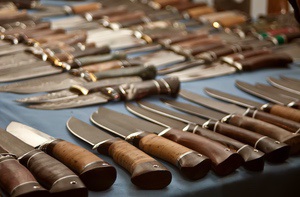
When it comes to knife making, the right steel can make all the difference. The wrong type of steel can make a blade hard to sharpen, brittle, or dull too quickly.
The main factors a good blade steel should have are hardness, toughness, corrosion resistance, and edge retention. Each of these must be balanced to provide the best performance.
Hardness
When it comes to making knives, you need a steel that is hard enough to take and hold an edge, but also tough enough not to chip or break. In addition, you need one that won’t rust even in the most extreme conditions.
There are a variety of different types of steel used in knife making, including carbon, stainless steel, and alloy steel. Each type of steel has its own set of properties that can be altered by heat treating or using different techniques during the manufacturing process.
The most common type of steel used in knife making is carbon steel, which is the base material for most knives. Carbon steels can be hard (HRC 55-66), medium (HRC 60-62), or soft.
Toughness
Knife makers have a difficult time finding the right balance between edge retention, toughness, and corrosion resistance. That balancing act is important for a knife that can perform well in a variety of situations and environments.
Toughness is a property of steel that essentially measures how well a blade can resist chipping, breaking, or cracking when exposed to extreme force, hard materials, or heavy use. Toughness also has an impact on how a blade can hold its shape over long periods of time, which is why it’s an important consideration for survival knives and combat-style knives.
There are several different ways to measure the toughness of a steel, but the best guidance comes from transverse rupture strength (TRS) measurements. The higher the TRS of a steel, the more resistant it is to tearing and cracking under normal use.
Corrosion Resistance
For knife makers, it’s essential to choose a steel that will hold an edge and resist corrosion. This is especially true if you’re going to use your knives outdoors or for tough cutting tasks.
A good way to tell if a steel is good for knife making is to test its hardness with the Rockwell test. This is done by forcing a diamond point into the blade at a set pressure and measuring how deep it penetrates.
There are many different kinds of steels that are used for knife making and it’s important to pick one that’s best suited to the task at hand. Some of the most popular choices include carbon steels and stainless tool steels.
Edge Retention
One of the most important aspects of a knife is edge retention. It is the ability of the blade to maintain its sharpness over a period of time, usually due to the presence of carbide in the steel.
Hardness is another key factor in edge retention and hardness goes hand in hand with toughness. It is possible for a blade to be very hard but still be brittle and prone to chipping and breaking.
Tool steels are the most common steels used in knife making because of their high corrosion resistance and wear-resistant properties. They also have good hardness and tensile strength to allow for strong and durable knives.
CPM S30V and Crucible’s S35VN are two of the most popular knife steels, containing small amounts of niobium to improve toughness and ease of sharpening. Carpenter’s CTS-XHP steel is a new powder metallurgy creation that offers slightly better edge retention than S30V but requires more work in the sharpening process.
